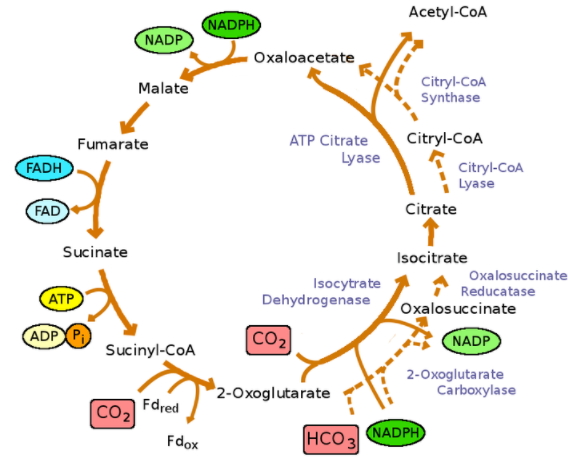
Krebs cycle is also called as
A. TCA cycle
B. Citric acid cycle
C. Tricarboxylic cycle
D. All of the above
Answer
552.3k+ views
Hint: Krebs cycle was discovered by H.A Kreb who is a German-born British biochemist. It is the process of oxidation of glucose, fatty acid, and amino acids to produce energy. This cycle occurs in all aerobic organisms and it takes place in the matrix of mitochondria.
Complete answer:
Krebs cycle is an eight step cycle that occurs in the matrix of mitochondria. This cycle is an important metabolic pathway that connects carbohydrate, fat, and protein metabolism. It is a series of chemical reactions where energy is in the form of ATP (Adenosine triphosphate) which is produced by the oxidation of acetyl-CoA which is obtained from carbohydrates, fats, and protein. This is the reason the Krebs cycle is also known as metabolic sinks as it is a common pathway for fats, proteins, and carbohydrates which acts as a respiratory substrate and releases energy.
In this cycle redox, dehydration, and decarboxylation reactions take place. It utilizes two and four-carbon molecules to produce a six-carbon molecule which further produces carbon dioxide, ATP, and NADH (Nicotinamide dinucleotide), and FADH2 (Flavin adenine dinucleotide).
The name of this cycle is also known as citric acid because it is the first product generated by the sequence of conversions which is consumed and regenerated in the series of reactions to complete this cycle. It is also called the TCA tricarboxylic acid pathway as it contains a carboxyl group (COOH). This cycle plays a key role in the catabolism, or breakdown of organic fuel molecules such as glucose, fatty acids, and some amino acids.

Note: In the case of a prokaryotic cell, the Kreb cycle or TCA cycle occurs in the cytosol because mitochondria are absent in prokaryotic cells. NADH and FADH2 released in the TCA cycle are used up in the oxidative phosphorylation.
Complete answer:
Krebs cycle is an eight step cycle that occurs in the matrix of mitochondria. This cycle is an important metabolic pathway that connects carbohydrate, fat, and protein metabolism. It is a series of chemical reactions where energy is in the form of ATP (Adenosine triphosphate) which is produced by the oxidation of acetyl-CoA which is obtained from carbohydrates, fats, and protein. This is the reason the Krebs cycle is also known as metabolic sinks as it is a common pathway for fats, proteins, and carbohydrates which acts as a respiratory substrate and releases energy.
In this cycle redox, dehydration, and decarboxylation reactions take place. It utilizes two and four-carbon molecules to produce a six-carbon molecule which further produces carbon dioxide, ATP, and NADH (Nicotinamide dinucleotide), and FADH2 (Flavin adenine dinucleotide).
The name of this cycle is also known as citric acid because it is the first product generated by the sequence of conversions which is consumed and regenerated in the series of reactions to complete this cycle. It is also called the TCA tricarboxylic acid pathway as it contains a carboxyl group (COOH). This cycle plays a key role in the catabolism, or breakdown of organic fuel molecules such as glucose, fatty acids, and some amino acids.

Note: In the case of a prokaryotic cell, the Kreb cycle or TCA cycle occurs in the cytosol because mitochondria are absent in prokaryotic cells. NADH and FADH2 released in the TCA cycle are used up in the oxidative phosphorylation.
Recently Updated Pages
Master Class 11 Chemistry: Engaging Questions & Answers for Success

Why are manures considered better than fertilizers class 11 biology CBSE

Find the coordinates of the midpoint of the line segment class 11 maths CBSE

Distinguish between static friction limiting friction class 11 physics CBSE

The Chairman of the constituent Assembly was A Jawaharlal class 11 social science CBSE

The first National Commission on Labour NCL submitted class 11 social science CBSE

Trending doubts
What is meant by exothermic and endothermic reactions class 11 chemistry CBSE

10 examples of friction in our daily life

One Metric ton is equal to kg A 10000 B 1000 C 100 class 11 physics CBSE

Difference Between Prokaryotic Cells and Eukaryotic Cells

What are Quantum numbers Explain the quantum number class 11 chemistry CBSE

1 Quintal is equal to a 110 kg b 10 kg c 100kg d 1000 class 11 physics CBSE




